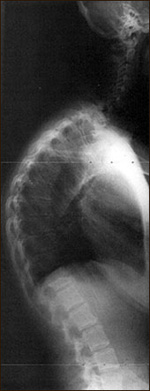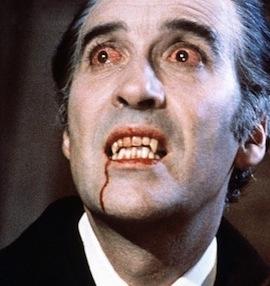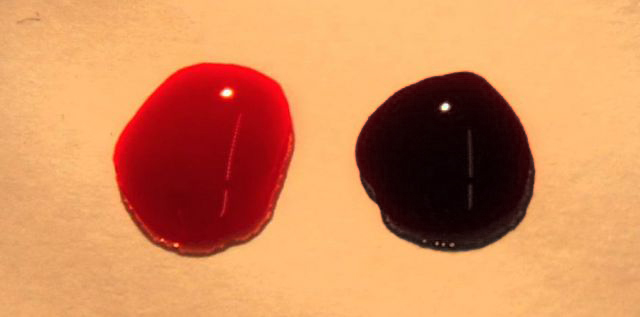Click here to read Part IV.
Muscular & Skeletal System
Adaptations in their skeletal and muscular systems give vampires
significant advantages over humans. Not only are they superb athletes
with enhanced strength and speed putting them on par with even
world-class sprinters and weightlifters, they can also perform much
longer before fatigue sets in.
Vocal Folds: During the coma, structural changes in the larynx
cause vampires to speak more quietly. As a result, their voices crack
when they try to shout, which is why they prefer to hiss, expelling air
through their clenched mouths. Over the years as their mucous membranes
thin and they lose elasticity in their vocal cords, a male vampire will
develop a higher, thinner-sounding voice, while a female's voice will
deepen. Contrary to some fiction, vampires do not growl like wolves or
roar like lions, though they can emit high-pitched shrieks if they
scream loud enough.
 |
X-ray of a vampire's
curved spine. |
Muscles/Connective Tissue: About 90% of vampire muscles are of
the fast-twitch variety—compared to 50% for the average human. This
brand of musculature enables short bursts of maximal force, ideal when
hunting prey. However, unlike typical fast-twitch muscles, vampire
muscles are highly resistant to fatigue, thanks to a drastic increase in
mitochondria. Much like cardiac muscle, this allows a greater amount of
activity without lactic acid buildup. This makes a newly-turned vampire
3 to 5 times stronger than before transformation, with a top running
speed of 25 to 30 miles per hour, and a vertical leaping ability of at
least 10 feet. Ligaments and tendons thicken in response to the workload
imposed upon them by the muscles, and gradual fluid loss causes a
vampire's muscle tissue to shrink (but with no apparent loss of power).
Skeletal System: Osteoblast production causes a vampire's entire
skeleton to harden and thicken, both during the coma and after each
feeding. This makes their bones much more efficient at absorbing shock
from high-impact forces such as jumping, falling, blunt trauma, and even
bullets. As a vampire loses its fat and water stores, its overall
height will shrink down by 1 to 3 inches, due to a gradual contraction
of the ligaments between the joints and spinal vertebrae. The latter
symptom causes the spine to curve into a hunchback, a condition known as
kyphosis. The taller a vampire is, the more height it will lose, since a
longer spine will curve more than a shorter one.
Respiratory & Digestive System
A vampire's slowed metabolism allows them to survive on a purely-liquid diet, as well as less oxygen.
Lungs: Oxygen use is cut down by roughly half, allowing vampires to go longer without drowning or suffocating.
 |
|
What vampires are most known for. |
Saliva: Like vampire bats, vampire saliva contains a potent
anticoagulant known as Draculin. As a result, they do not suck blood,
but rather lap it up at the site of the hemorrhage. This same substance
is produced in the GI tract to keep blood from curdling in the stomach
so that it won't be regurgitated (which is what happens if a normal
humans drinks a large amount of blood). Vampire saliva also contains a
useful narcotic that renders victims less able to fight back.
Diet: As you may know, the average human body contains 5 to 6
liters of blood, but a vampire's stomach can only hold about 1.5 liters.
While a pack of vampires has no problem draining a single victim, a
lone vampire is forced to rely on a series of smaller feedings over a
period of several hours. This is where its narcotic-like saliva comes
in, as it keeps the victim sedated while the vampire goes back and forth
between feeding and draining its bladder. Similar to humans with solid
food, a vampire can go more than a month without drinking blood.
However, they're also different in that they can go equally as long
without any kind of water, while humans can only go about a week.
 |
|
A bottle of vampire urine. |
Digestion: Because blood is 50% water, half of it is shed through
sweat and urine, and the other half through defecation. As mentioned
before, a vampire will urinate shortly after each feeding, but
defecation won't occur until a day or so later. Should a vampire go a
long time without feeding, urination will only take place around once a
week, and defecation once a month. Like other carnivorous creatures, the
high iron content in human blood makes vampire excrement completely
black. Depending on how often they urinate, it can be anywhere from
clear to tea-colored.
Fat: Vampires experience a noticeable degree of weight-loss
during the coma, since they require a tangible amount of fuel to change
their body structure—hence why they're starving by the time they wake
up. Vampires who are overweight will shed the extra pounds over a matter
of weeks, thanks to their liquid diet and highly active lifestyle.
Despite the rapid weight-loss, hanging skin is never a permanent problem
for a vampire, since victims who are obese enough to cause irreversible
skin stretching never survive vampiric comas anyway. Needless to say,
vampirism is not a recommended weight-loss remedy.
 |
|
Photo by Stu Spivack. |
Dietary Substitutes: Vampires have trouble digesting solid food,
and soup is one of the few forms of sustenance they can hold down.
During the Middle Ages, vampires in urban areas often opened secret
restaurants called potages, after the French word for "soup." These
restaurants became their
de facto meeting places, as well as
shelters where they could hide out from hunters. As a result, soup
became a symbol of brotherhood among the vampire race, and only the most
trusted civilians were invited into their potages. Vampires are also
very limited in what they can drink: carbonated beverages such as soda
and beer are hard on the stomach, alcohol has a more adverse effect on
the brain and liver, caffeine causes intense headaches, and they're
lactose intolerant.
Dietary Restrictions: Aside from the fact that vampires can't
consume much else other than blood, they're also limited to mostly human
blood. While they can live several weeks on non-human mammals, such a
diet does not supply all the nutrients essential for their survival.
Non-mammals, such as birds and lizards, will only do for a few weeks.
Vampire blood is by far the worst substitute. In 1928, the Goessman
Institute restricted a total of 20 starving vampires to a diet of
vampire blood—1.5 liters per day. Although sated at first, they became
lethargic and disoriented after only 3 days. Within 10 days, all 20
vampires were dead. To put it simply: vampires must drink the blood of
humans, or die. It is this simple equation that drives their powerful
survival instinct. Not even blood bags will do for more than a few
months, as vampires absolutely require that thrill of hunting to
effectively metabolize each meal.
Cardiovascular System
The most profound differences between our species are found in the
circulatory system, as they enable vampires to survive injuries that
would kill a human being. Fortunately for us, their tissues are still
vulnerable to most kinds of poisons, toxins and venoms.
 |
A drop of human arterial blood compared with that of a vampire.
Notice the reddish-brown tint near the edges of the latter. |
Blood: Known as ichor (pr. ik-er), vampire blood takes on a much
darker color due to an increase in iron and other toxins that escape
from the liver and spleen. This ichor darkens even further over the next
three to four months as a vampire feeds and replaces its blood supply.
Although vampire blood appears black, arterial blood is actually a dark
rusty red when diluted. The extra iron not only darkens the blood, but
makes it clot faster as well. And although a vampire's oxygen intake is
lowered by its slowed metabolism, the blood oxygen itself actually
increases thanks to the added iron storage in the new hemoglobin and
erythrocytes.
Heart: Vampire blood is pumped via the contraction of skeletal
muscle rather than the heart, which eventually atrophies from disuse.
This forces high-pressure venous blood toward the heart, which
constantly swells and drains as low-pressure arterial blood is pushed
away from it. While at rest, involuntary spasms known as fasciculations
take place in the limbs, and emanate from the furthest extremities
inward—similar to the wave-like peristalsis of the GI tract. Since it
affects the muscles required for movement, slight tremors are common,
but only when the muscles aren't in use. Voluntary diaphragm and
abdominal action also aid blood flow to the brain. Along with their
claws, hand tremors can be a dead giveaway for a disguised vampire, so
they'll try to keep them out of view while in public.
 |
|
Humans also pump blood this way, though it's strictly voluntary. |
BPM: Normal healthy humans experience a resting heart rate of 60
to 100 beats per minute, with the average being 72. Since vampires lack a
working heart, bpm must be determined using a single area of
fasciculation. There are three in all: calves, thighs and biceps. The
former are tensed first, then the latter two simultaneously, and then
all three are relaxed at once—a process that takes about a second to
complete. These points of contraction are called "vasonodes," or simply
"nodes." A newly-turned vampire starts out with a node bpm of around 50,
which drops into the 30s over the next few days as its yellowed skin
turns blue. Over the next few months it finally stabilizes into the 20s,
and sometimes even the teens, with the record being a mere 10. Like
fully-functioning hearts, these muscles will pump harder and faster in
response to physical exertion, while the opposite occurs during sleep.
|
|
Some humans experience fasciculations as well. |
Blood Pressure: Because the skeletal muscle pumps take over
circulation from the heart, the cardiovascular system experiences a
drastic pressure reversal: the veins now exceed the arteries. This is
referred to as "introverted circulation," or "undead circulation," while
normal humans possess "extroverted circulation." This is sufficient to
sustain a vampire, as not only do their cells require less oxygen, the
blood itself can transport more of it at once, and most of the arteries
flow
with gravity rather than against it. A couple exceptions are
the carotid and vertebral arteries, but the lower veins and arteries
constrict enough to allow as much pressure as possible toward the brain.
Perhaps the biggest upside to this reduced blood flow is that it also
helps the blood clot faster, preventing fatal bleeding even in major
arteries.
Adrenaline: This "emergency hormone," produced by the adrenal
glands, is released in consistently large amounts in vampire blood
during "fight-or-flight" situations. This quickly raises a vampire's
sluggish metabolism by increasing blood flow, dilating air passages and
accelerating the production of clotting factors. Along with changes in
muscle, bone and connective tissue, this ability to release adrenaline
only adds to a vampire's extraordinary power.
Disease Resistance: In addition to natural antibiotics that slow
the growth of bacteria, most viruses are simply incompatible with
vampire cells thanks to changes in their surface proteins. There has
also never been a reported case of a vampire having cancer. In fact,
vampires who had cancer when they were infected lose all traces of the
disease within a few months after transformation. This resistance to
disease is not surprising, considering that the HVV virus can infect
every tissue in the body without causing cancer or fatal bacterial
infections.
 |
A vampire after taking four gunshots
to the chest, with no apparent effect.
Date: November, 1815. |
Clotting/Healing: Vampire blood clots much faster upon injury
than with humans, which plays a major role in why they're so resilient.
Gunshots and stabbings to the torso—including the heart—are largely
ineffective as a result. Healing rate is more than doubled as well.
Along with increased iron levels, this is in thanks to the larger number
of blood cells responsible for clotting and tissue repair. Vessel
obstructions never seem to be a problem for vampires, since they don't
get fatty plaque and the body is better at dissolving clots inside
healthy vessels.
Medical Applications: Along with their profound resistance to
disease, there was considerable research into vampire circulation and
possible applications for human medicine. One such breakthrough was the
ventricular assist device, which allows humans to live without a
heartbeat. There's also a physical exercise based on this method of
circulation, which involves tensing and relaxing one's leg and arm nodes
while at rest. Not only does it strengthen the muscles, it also
improves venous circulation and nerve control. As for faster clotting
abilities, the problem of vessel blockage formation has yet to be
solved.
Medical Complications: Depending on the particular model, a
vampire wearing a pacemaker upon transformation may experience agonizing
pain from the constant shocking of their paralyzed heart, until the
device runs out of power. However, this only applies to the older
models: the newer ones only shock the heart a certain number of times
before deactivating. Of course, people with pacemakers are usually too
old or infirm to survive the coma anyway. Victims bearing transplanted
organs will always die, even if they're vaccinated before the coma. This
is due to their chemically-suppressed immune system being too weak to
combat the virus, which then strengthens the immune system enough to
attack the foreign organ, which in-turn kills the host. Pregnant women
who are bitten will always miscarry, and they can even die if left
unvaccinated (depending on how developed the fetus is). In fact, there
were many cases of desperate women seeking out vampires and their blood
to abort their pregnancies, starting from 1950 when the vaccine was
created up until 1973 when
Roe v. Wade was decided.








No comments:
Post a Comment